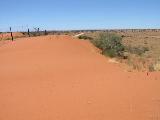|
|
 |
 |
|
Desert Landscape
|
 |
|
Kalahari Desert
The Kalahari plateau lies at about 1100 metres elevation in southern Africa, and is about the size of France, i.e. 260,000
km2. It is mostly flat, and together with Namibia's Skeleton Coast, it is the worlds largest body of sand. (The Sahara is
larger but it only has pockets of sand dunes.)
|
 |
|

Although Namibia is more famous for being the home of the Namib much of eastern Namibia is covered by the Kalahari Desert.
The Kalahari is not a true desert as it receives too much rain(!), it is actually a fossil desert.
Do not expect
to find the tall sand dunes associated with the desert, the landscape is more one of golden grass and small red dunes.
It comprises both windblown sand and, in the north, sand from river deposition. The sandy soil soaks up any rain even
in the wetter north and east, so that surface water is rare.

The area surrounding Pokweni consists of large farms specializing in sheep it has a truly unique atmosphere with herds of
Gemsbuck and Springbuck, Ostriches, Eland, squirrels, and many more share this beautiful but arid area together with the local
sheep the Dorper Ooi.
|
|
 |
|

The area is crossed by long red dunes which run from north west to south east in between the dunes are clay pans which occasionally
flood with water after heavy rains. Only in recent geological history, 10 to 20,000 years ago, were the dunes stabilised through
vegetation.
The Copper Red sand masses were created by the erosion of soft stone formations. The wind shaped the
sand ridges, which are so typical of the landscape in the Kalahari.


|
|
 |
|
 |
|
